| |
Volume 3, January 2012
Franco Petracchi and the Divertimento Concertante Per Contrabbasso E Orchestra by Nino Rota: A Successful Collaboration Between Composer And Performer
by Alexandre Ritter
Chapter 2 — The Genesis of the Divertimento
2.1 — Brief Biographies of Composer and Performer
2.1.1 — Nino Rota
Although this document is not intended to be an in-depth biographical study of Nino Rota and Franco Petracchi, some insight on their lives is necessary to place both musicians in a historical context.
Nina Rota is best known as the composer of the first two of The Godfather films, directed by Francis Ford Coppola. Rota was born in Milan (1911) and died in Rome (1979). Considered a prodigy, at the age thirteen he had his first performance of the oratorio L'infazia di San Giovanni Battista. In 1923 he started his studies at the Milan Conservatory and in 1926 moved to Rome where he studied privately with Pizzeti (1925-6), and later entered the Accademia Santa Cecilia where he studied with Casella. Encouraged by Arturo Toscanini he went to the United States in 1931 to study at the Curtis Institute in Philadelphia. There, he studied composition with Rosario Scalero and conducting with Fritz Reiner. In his time in the USA he became friends with Aaron Copland and was deeply influenced by American popular song, the music of Gershwin and cinema.29 After he finished his studies in the USA, Rota returned to Italy where he entered the University of Milan and earned a degree in literature. In 1939 he became a lecturer at the Liceo Musicale in Bari Conservatory, where he later (1950-77) served as its director.
Although Rota is considered by many as one of the greatest Italian film composers of all time, he produced an enormous amount of concert music. In the article "Side by Side, Nino Rota, Music, and Film," Richard Dyer praised Rota's productivity in detail: "He was extremely busy: in addition to writing 157 film scores, he composed 74 concert works and 28 works for theater, opera, ballet, and television, and he conscientiously filled a full time post as director of the Bari Conservatory of Music."30 A closer examination of Rota's catalog shows that he produced 12 complete operas, more than 30 dramatic works such as ballets and incidental music for stage, radio and television, three symphonies, more than ten concertos, more than ten other orchestral pieces (in which the Divertimento for bass is included), more than 15 different chamber works, 60 different vocal works, and as Dyer mentioned, more than 150 film scores.
Giordano Montecchi described Rota's musical style as follows: "He contributed to the renewal of Italian music with a body of work that has an immediacy of gesture and is rooted in a rare lyricism, built on harmonic languages, formal structures and rhythmic and melodic idiom which sound distinctive and original."31 The expressive element in Rota's music finds its inspiration to convey an idea, a feeling, or an imaginary scenario where serenity is the ultimate goal. John Simon, in the article entitled "The Other Rota," quotes from Rota words what he thinks is the "prototypical Rota utterance:"
When I am at the piano and I look for inspiration for my music, it may be that I am happy. But, as a man, how can one be happy amid the unhappiness of others? . . . If I could make everyone around me have a moment of serenity, I would do all I can. Basically, this is the sentiment that animates my music.32
Listening to Rota's music one becomes aware of his intention of "serenity," mainly through his wise and unique use of agreeable harmonies, but one senses, also, his fraternal feelings of the consciousness of universal human "unhappiness." Dyer, when writing on Rota's style in film music, quotes Rota's words on his style "of music that 'expresses above all the spirit of the film rather than the materiality of the succession of images.' "33
2.1.2 — Franco Petracchi
The author met maestro Petracchi for the first time in the winter of 1994 at the University of Georgia, during the Double Bass Symposium III organized by Dr. Milton Walter Masciadri. Petracchi demonstrated his pedagogical artistry and musical ability during his master classes. His comments to the students were insightful and of great benefit, impressing even the audiences who attended the Symposium.
Petracchi was born in Pistoia (1937), and currently lives in Rome. He graduated summa cum laude from the Santa Cecilia Academy of Music in 1958 under the guidance of Guido Battistelli. During the same period he studied conducting with Franco Ferrara and composition with Di Donato and Margola. He gave his solo debut in 1961 at La Fenice in Venice. As a soloist he performed with conductors such as Bernstein, Karajan, Celibidache, Kubelik, Jochum, Sawallisch, Giulini, Mutti, Metha, Maazel, Barbirolli, and Munch, among others.34 Many important composers have paid homage to his artistry, writing and dedicating works for him "including Mortari's Sinfonia Concerto (1960), Mortari's Concerto per Franco Petracchi (1966), Mortari's Duettini Elegia e Capriccio (1976), Morricone's Studio 89, Berio's Duetti per Violoncello e Contrabbasso, Rota's Divertimento Concertante, and Armando Trovajoli's 'Sconcerto'."35
As an orchestral player, he joined the Turin Rai Symphony in 1960 as principal bassist, and in 1962 he moved to the Rai Symphony of Roma, where he stayed until 1980, when he decided to devote his career fully to solo playing and conducting.
Petracchi is a very influential teacher. His academic career began in 1971 when he won the Double Bass chair position for conservatories such as Frosinone, Bari, l'Aquila as well as Rome. In 1986 he started teaching at the Geneva Conservatoire where he taught the classes of Virtuosité until 2009. His master classes at the Walter Stauffer Strings Academy in Cremona, Accademia Musicale Chigiana in Siena, Campus Internazionale di Musica in Sermoneta, and at the Gubbio Summer Festival in Gubbio draw students from around the world. In an interview with Lucia Borsatti, Petracchi commented on his own beliefs and his pedagogical approach:
I give everything to my students, and in return I expect them to be totally committed to the job in hand. When I first meet a prospective student I am really severe. That is to say I tell him the truth, the whole truth, everything . . . But if they survive, I know they will succeed.36
Even though Petracchi has several live-performance recordings, he has decided not to record in studios. In the article entitled "Passioni Amorose," Francisco Catala asked him about the lack of studio recording. Petracchi responded, "I am very proud and I believe that to record in a studio is false because it is not the image of the artist. I've listened to artists play superbly on disc, but then in a theatre they weren't really that impressive. Therefore, I just like live recordings because they tell the truth."37 Petracchi's many live performance recordings include the following: Rossini's Sonata per Contrabbasso e Violoncello (Philips), Bottesini's Gran Duo (for Sony), Bottesini's Passioni Amorose (ASV), Sinfonia — Concerto (Edipan Roma), Bottesini's Tarantella (Pull), Zbinden's Divertimento (Espace Suisse Romande), and Rota's Divertimento (Panne Enterprise — Takuma Foundation Tokyo). In addition to his busy career as a soloist and teacher, Petracchi is active as a conductor and composer. Some of his pieces include Valse Oublièe, Belle Epoque for Orchestra (from Johannes . . . to Richard Strauss), and Valzer da Concerto for piano (a virtuoso and romantic piece).
Petracchi's contributions to the evolution of bass technique are highly praised throughout the world. In the article entitled "The Master of Bel Canto," Lucia Borsatti comments, "It is no exaggeration to say that Petracchi has created a new way of playing the bass; in fact it is unquestionable that double bass technique has been revolutionized over the last 20 years or so."38 Petracchi solidified his pedagogical reputation in 1982 when he published a method book entitled Simplified Higher Technique.39 In his book he elevated the instrument's technique to the standard of other string instruments, even incorporating technical concepts associated more often with piano performance. In the article "Left Hand High," Peter Buckoke gave a typical assessment of Petracchi's influence on his own playing:
I was lucky to find my way onto Franco Petracchi's summer course in Vicenza, northern Italy. He introduced me to his daily exercises, which were unpublished at the time, but are now available from Yorke Edition. . . . I have worked with his exercises continuously over the last 30 years . . . 40
2.2 — Historical Background on the Divertimento and on Simplified Higher Technique
In the first chapter of this document, the author has presented basic information regarding the compositional chronology of the Divertimento and given reasons for investigating Petracchi's Simplified Higher Technique as a significant shaping influence. In this chapter both the compositional history and the influence will be explored in more detail. Much of the material presented here has been taken from the 2008 interview between the author and the performer, which is a valuable source for the genesis of both the Divertimento and Higher Technique.41 Like the interview itself, the discussion will proceed according to the chronology by which the four movements of the work were composed, i.e., Marcia, Aria, Finale, and Allegro respectively. At the end of this section an overview of the Higher Technique will be presented, in preparation for the discussion of it as an influence. Appendix A of this document contains the entire 2008 interview with Petracchi in Italian, followed by a full translation into English. The author recommends that the interview be read in full as it contains many interesting details that were not included in this section.
According to Petracchi, the Divertimento "was born" as a result of his request to Rota to write a single piece for bass and piano in 1967. At that point in time, Petracchi had just been invited to teach at the Bari conservatory, while Rota was its director. The performer recalls: "I [Petracchi] accepted and could not miss the opportunity to ask him to write some music for my instrument."42 Petracchi explained that Rota had his office underneath his classroom and that Rota could hear the content of Petracchi's lesson.43 The Marcia was composed as an exercise for the double bass class, designed to challenge the student with specific techniques, Petracchi stressed Rota's intention with the Marcia:
This Marcia contained numerous exercises that I used to give to my students, a kind of training music, realized in living music to "make them [the exercises] more enjoyable," as he [Rota] said. In fact his studio and his sitting room were situated right below my classroom. It certainly was not enjoyable for the Maestro to rest at certain times with that "concert of scales."44
The tempo marking assigned to the Marcia reflects the collaborative decision made between Petracchi and Rota. In the interview Petracchi recalled that "he [Rota] made a point of telling me that the time must be allegramente, like when children leave school, not when they enter. We estimated that a quarter-note at 132/138 could be optimal."45
In 1968 the Aria was composed.46 According to Petracchi, when the prominent Italian critic and musicologist Fedele D'Amico heard the Aria performed in Rome, he declared after the concert that this Aria was one of the best Italian pieces written in the last 50 years.47 In his recollection, Petracchi claims that the music for the Aria owes its existence to Rota's concurrent project of composing music for the famous film Doctor Zhivago:
It's important to clarify that this music (Aria) was originally written as the motif of the film Doctor Zhivago. Due to disagreements with the production, he withdrew (the beautiful score was then written by Lai with "Lara's Theme") and to our great satisfaction, Rota's theme was "redirected" to the double bass.48
In an early conversation about it, Rota revealed to Petracchi that he had already formed a clear idea of where the music of this Aria would be used in the soundtrack for Doctor Zhivago According to Petracchi, "For the interpretation, he told me that I should think of a slow march of Russian exiles heading toward Siberia [at RN 4] at night and then, bit by bit, lentamente and with ampiezza, at the unfolding of dawn (like Respighi's "I Pini di Roma")."49
The Finale was the third movement composed and dates from 1969.50 Inititally Rota had thought of it as a galop with respect to its musical style.51 By the time the Divertimento was published in 1973, however, Rota had decided to call it Finale.52 When this Finale and the earlier two movements had been scored for double bass and piano, Petracchi asked Rota about another stage of work: "After the finale (galoppo), he [Rota] had already thought about a possible orchestration . . . when I proposed it to him, he told me that he had already planned it."53
An additional movement, entitled Allegro and intended to be played first was composed in 1971.54 Petracchi recalls several unique factors that influenced the composition of this movement:
He explained to me that the theme is drawn from the Concerto No. 1 of Paganini modified in the final note, the nightmare of a double bassist who imagines that a concerto has been written for him, but that he is unable to get the final note right, played invariably one tone below the original. A nightmare!55
The composition of the first movement's development became a particular concern. Petracchi remembered that the orchestral introduction was longer than the entire section with bass, Petracchi recalls his suggestion to Rota:
I pointed out that in the first movement, after the long introduction, the double bassist played a brief entrata and then passed to rehearsal number 10 of the cadenza, practically missing the development. He said that I was right. "I'll take care of it. How demanding you are!" In fact, he took care of it, but only two days before the first performance held in Napoli in 1971.56
Based on his interactions with the composer during and just after the composition of the Allegro, Petracchi has argued against using the tempi that appear in the published edition:
I have had the chance to hear several recordings of this divertimento, but not one renders the thought of the composer, truly an interpretative loss . . . on my own score, which I also distribute to my students, there are numerous expressive, dynamic, and metronome markings that are fruit of my time with Rota at the piano.57
At the same time that Rota was composing the Divertimento, Petracchi was introducing the ideas that he would later publish in Simplified Higher Technique into his teaching at the Conservatory.58 In a quotation presented earlier, Peter Buckoke claimed that he had been exposed to the basic concepts before 1973,59 even though the book was not published until 1982.60
Petracchi was quite specific as to his purpose for transforming his pedagogy into a published method; he stressesed the fact that he took ideas from the technique of other instruments, such as the piano:
At the time, I suggested to my students exercises to improve their performance to facilitate their study; some I created, and others I took from other instruments. In that period, the 1950s, there was no school of thought regarding technique. I found inspiration in piano technique, the same methodology, a double bass fingered horizontally instead of vertically. My own students encouraged me to publish these "notes" in order to avoid writing them with some occasional notes [in class].61
2.3 — Petracchi's Simplified Higher Technique: Structure and Style
Franco Petracchi's Simplified Higher Technique is a method book for double bass published by Yorke Edition in 1982.62 The book is comprised of 20 chapters, each of which features some combination of one or more exercises, etudes, or excerpts from solo and orchestra repertoire. For the most part, the exercises in the method are Petracchi's original compositions and incorporate his innovative concepts of left hand technique. Petracchi achieves these innovations by using the thumb position technique in unorthodox registers and positions on the finger board. He also introduces different pre-set left-hand positions, all of which use the thumb as the base for the positions. Such positions were remarkably innovative at the time due to the unusual fingerboard placements. In most methods published before Higher Technique, the thumb is only used above the midpoint of the strings (e.g., beyond the g1 — midpoint of the G string), Petracchi, however, uses different thumb positions below the midpoint of the finger board, as will be demonstrated.
Petracchi also introduced the technique of using the thumb in order to play almost any note on the fingerboard, including such unlikely ones as an e1 or a b1 on the first string. To supplement the presentation of innovative ideas, he incorporated exercises from other methods, borrowing examples from composers such as Billé, Caimmi, Mortari, and Selmi. Furthermore, he applied his technique to important examples from the bass repertoire, from composers such as Henze, Hindemith, Koussevitsky, Mussorgsky, Bottesini, and Fryba.
Petracchi's innovations are based on the establishment and manipulation of three different left hand positions: chromatic (cr), semichromatic (s.cr), and diatonic (diat). All three different left hand positions make use of the thumb as the base for the hand position.
The chromatic position (cr) is built on three consecutive semitones using the thumb for the first note, finger 1 (index finger) for the second note, finger 2 for the third note (middle finger), and finger 3 (ring finger) for the fourth note, as shown in the example below:

Example 1. Example of Petracchi's chromatic fingering system (chapter 1, p.1).
The semichromatic position (s.cr) is built on the span of a whole tone and two consecutive semitones. The whole tone is produced by the use of the thumb and finger 1, while the other two consecutive semitones are produced with fingers 2 and 3 as shown in the example below:

Example 2. Example of Petracchi's semi-chromatic fingering system (chapter 1, p.1).
The diatonic position (diat) is built on a whole tone between the thumb and the finger 1, another whole tone between the finger 1 and the finger 2, and a semitone between fingers 2 and 3 as shown in the example below:

Example 3. Example of Petracchi's diatonic fingering system (chapter 1, p.1).
On the basis of the three basic positions presented in his method, Petracchi devised more extended positions, always using the thumb as the base for the left-hand positions. Such variations on the three basic positions are of great use in the realization of various works in the double bass repertoire, especially for the execution of fast passages. Two examples of these extensions can be seen in example below:

Example 4. Example of fingering extensions (chapter 1, p.1).
A detailed examination of some of the chapters presented in his method will reveal how Petracchi uses his three basic positions and how he progressively helps the player to strengthen the left hand. Both of these acquired skills are particularly useful in performing Rota's Divertimento, since numerous passages in it are indebted to his approach. In Chapter 2, Petracchi uses the G major scale to require the player make use of all three positions. By placing the thumb on g1, the player will have formed the s.cr position with the notes g1 (+), a1 (finger 1), a1-sharp (finger 2), and b1 (finger 3). Subsequently he must place the thumb on a1, which will form a cr position for the left-hand with the following finger placements: a1 (+), b1-flat (finger 1), b1-natural (finger 2), and c2 (finger 3). The exercise proceeds to the end of the G major scale when the player uses the diat position, placing the thumb (+) on d2, e2 (finger 1), f2-sharp (finger 2), and g2 (finger 3), as shown in the example below:

Example 5. Exercises for the three basic positions (chapter 2, p. 2).
In Chapter 4, instead of using the diatonic notes of a scale as in chapters 2 and 3, Petracchi requires the player to work on each position going up the chromatic scale, semitone by semitone.63 The exercises in Chapter 4 are very demanding for the left hand, requiring not only precision in intonation but also the building of resistance in the muscles and tendons. In Chapter 5, Petracchi presents both major and minor scales. The main goal in this chapter is to introduce to the performer the use of the diat position in order to play the end of any major scale (5a).64 Using the concept of a diat position resembles the execution of a scale played on the piano in which the position of the hand can stay still in order to play the last four notes of any major scale regardless of register in the keyboard. In order to achieve this, Petracchi has the student positioning the thumb on the fifth scale degree of any major scale, regardless of register, as shown in the example below:

Example 6. Major scale fingerings (chapter 5, p. 8).
Later in Chapter 5, Petracchi applies the same principal discussed above to the minor scales in their ascending melodic form. In the descent (i.e., the natural minor) the fingering must change from a diat to an s.cr position in order to play scale degrees 8, 7, 6, and 5, as shown in the example below:

Example 7. Minor scale fingerings (chapter 5, p. 8).
The emphasis of Chapter 7 is on the perfection of intonation, the building of resistance, and the strengthening of the left hand.65 In this chapter Petracchi once again proceeds chromatically, adding intervals of thirds and fifths to further develop precision in intonation; this feature is especially evident in 7c and 7d.66 Furthermore, Chapter 7 also shows how Petracchi coordinates the left hand with right hand technique, e.g., by providing the player with six different bowing variations.67 Similarly, in Chapter 8 Petracchi employs his left hand positioning to assist in playing octaves precisely in tune, giving the player another six different bowing variations.68 In Chapter 9 Petracchi makes use of Selmi's etudes, as he shows how his positions can help the performer to play accurate major thirds and perfect fifths consecutively (using the thumb and finger 1, and finger 1 and finger 3 accordingly) as shown in the example below:

Example 8. Exercises for thirds and fifths (chapter 9, p. 15).
As will be shown in Chapter 2.4 of this document, the techniques presented in Chapter 9 will be very useful when realizing some of the passages from the Divertimento, especially several in the first movement.
Chapters 10, 13a, b, c, d, and e, 15a, and b are actual excerpts from the double bass repertoire, taken from the music of such composers as Henze, Hindemith, Koussevitsky, Mussorgsky, Bottesini, and Fryba. Petracchi applies his fingering choices to each excerpt, applying fingerings worked out in the preceding chapters.
Petracchi explores the mobility of the left hand, i.e., the use of extensive shifts, in Chapter 11.69 In the exercises given, the player is required to shift the left hand one octave on the same string (it is suggested that this be played on the first but also on the second strings). Petracchi gives different variations of fingerings so as to provide the player with maximum possibilities between shifts with different fingers. In addition, a slide is to be played between the departure note to the arriving note as shown in the example below:
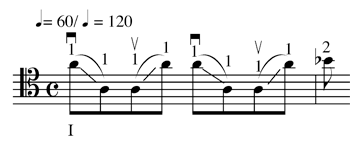
Example 9. Exercises for left hand agility (chapter 11, p. 16).
In Chapters 17 and 18 Petracchi develops exercises that involve dominant seventh arpeggios (17), arpeggios (in the major mode), and harmonics (18).70 In Chapter 19 Petracchi reintroduces a very interesting concept of playing the interval of a fourth using a special thumb position.71 He explains:
Fourths in thumb position are difficult. One solution is found by adapting the old method of pulling the string to one side. The normal part of the thumb presses the string down, in position, whilst the tip presses the lower string to the right ( ). NB. The lower string is not pressed to the fingerboard."72 ). NB. The lower string is not pressed to the fingerboard."72
Such technique can be seen in the example below:

Example 10. Thumb-only fingering for fourths (chapter 19, p. 27).
Finally, in Chapter 20 Petracchi applies complete fingerings to three advanced studies by Italo Caimmi, Isaia Billé, and Annibale Mengoli to demonstrate the potential of his positioning technique.
The next chapter will present the results of the author's investigation of Petracchi's pedagogy and his Higher Technique on the Divertimento. The commentary will be focused on the passages that are most similar to the exercises and etudes of Higher Technique.
2.4 — The Influence of Petracchi's Pedagogy and his Simplified Higher Technique on the Divertimento
Now that the general content of Simplified Higher Technique has been summarized, it will be possible to investigate its shaping influence, together with Petracchi's pedagogy in general, on the Divertimento. Each passage chosen for comparison will be related to a specific chapter and/or exercise from Higher Technique. The intent is not to find exact quotations from Higher Technique in the Divertimento, but rather to locate passages in the Divertimento whose style and idiom can be related to the specific innovations of Higher Technique. As already mentioned in Chapter 2.2 of this document, Petracchi was using Higher Technique in his daily teaching, in the years when Rota was writing the Divertimento, upstairs in his office. How did the exercises and etudes from Higher Technique influence Rota and how much of what he heard did he incorporate into the Divertimento? These questions will never have an absolute answer because the composer is no longer among us. Nevertheless, there are passages in the Divertimento that reflect the pedagogical goals facilitated when the specific innovations of the Higher Technique are employed. When relevant to the discussion, the author will be incorporating his own experiences with Petracchi's pedagogy, based on lessons that occurred at six music festivals and elsewhere. While these encounters occurred after the years of composition and revision, the pedagogical content is consistent with what has been presented in this chapter.
The comparative analyses will be presented with examples from the Divertimento, movement by movement, in the chronological order of composition. Sub-chapters have been created to identify each example from each of the four movements in the Divertimento. The ordering of the comparative examples will vary, depending on the case at hand.
2.4.1 — Marcia
The first compositional result of the collaboration between Rota and Petracchi was the Marcia movement. It is filled with many passages requiring the mastery of the basic techniques that are fundamental to Petracchi's training of performers. In every master class in which the author studied with him, Petracchi emphasized the necessity of working scales and arpeggios for every student, regardless of his or her level. Many passages in the Marcia give opportunities to demonstrate both scales and arpeggios.
The first theme presented by the bass is developed from a G major arpeggio as shown in Example 11 below. It is the first of many passages that call for the mastery of arpeggio patterns that was so fundamental to Petracchi's teaching:
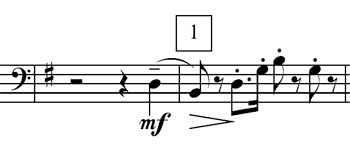
Example 11. Marcia, 1 m. before RN1 to RN1.
This same theme is used elsewhere in the movement, based on different tonal centers as well as modes, e.g., at 5 mm. after RN 1 where a C major arpeggio is written. Another instance occurs 4 mm. after RN 5, where a B-flat minor arpeggio is written, and another at 2 mm. after RN 12, where an E-flat major arpeggio is written. In Chapter 18 of Higher Technique, Petracchi presents a short exercise that develops the use of arpeggios that involve natural harmonics. They are also required in Example 12, which contains a G major arpeggio placed in the same register as the first bass entrance in the Marcia:

Example 12. Higher Technique (chapter 18, from measure 17 to 18, p. 26).
Rota developed another motive to challenge the player with broken arpeggios. At 5 mm. after RN 3, a G major arpeggio is presented in a consecutive eighth-note pattern, as shown in the example below:
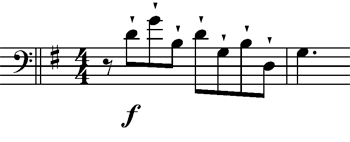
Example 13. Marcia, 5 mm. after RN 3.
Later in the Marcia, Rota uses this same motive with different tonal centers: one of them is at RN 4 where a C major arpeggio is presented, and another at 5 mm. after RN 8, where an A-flat major arpeggio is presented.
The use of multi-octave scales in the Marcia is also prominent. The first instance of a clear usage of a scale begins at 2 mm. before RN 2, where a two-octave ascending F-sharp major scale is presented. At 3 mm. after RN 2, a two-octave descending F major scale is presented, as shown in the example below:

Example 14. Marcia, 3 and 4 mm. after RN 2.
In four other instances Rota employs major scales as follow: at 3 mm before RN 3, an A-flat major scale is presented; at 3 mm. after RN 10, an ascending two-octave C major scale is presented; at 3 mm. before RN 11, an E-flat major scale is presented; and, in the last 3 measures of the piece, a complete three-octave ascending G major scale is presented as shown in the example below:

Example 15. Marcia, 3 final measures.
Petracchi's left-hand technique with a special use of the thumb is well-suited to the performance of rapid scales in several octaves. As discussed in Chapter 3.3 of this document, the traditional methods only use the thumb for the harmonics G, D, A and E (in the middle of each string) and also one octave above that, in the higher harmonic positions. The other use of the thumb in these methods is for the production of artificial harmonics. In Petracchi's system, the thumb can be used for any note above and below the midpoint of the strings, regardless of whether they involve natural harmonics. Therefore, the thumb can be used for notes that must be totally pressed down to the fingerboard. In his method the F major scale, for instance, uses the thumb for a c2, without a natural harmonic, as shown in the example below:

Example 16. Higher Technique (chapter 5, F-major scale, p. 8).
The major advantage to this technique is the increased ability to play fast passages: in effect, the bassist gains one more finger. We can clearly see Petracchi's influence on Rota's music when Rota writes an entire two-octave descending F major scale in the Marcia, 3 mm. after RN 2, as shown below. The revised version has been employed here (with Petracchi's hand-written fingerings) in order to demonstrate how well Petracchi's fingerings fit this passage:

Example 17. Marcia, 3 mm. after RN 2.
Clearly the identical fingering is used in both the method and the passage. It is also important to mention that the Marcia was assigned the tempo Alla Marcia, allegramente, with the quarter note = (approx.) 140. At this very fast tempo it is extremely difficult to play in tune without the use of the thumb on the c2.
The use of the thumb in unorthodox positions is also of great help in playing chromatic scales in a fast tempo. Many exercises are included in Higher Technique for the purpose of improving the student's ability to play chromatic scales. Relevant examples of this feature are presented in chapters 7 and 8 of Higher Technique.
In Chapter 7 Petracchi uses the chromatic scale, one position after another, in order to develop the intonation and strength of the left-hand as it remains in a fixed position spanning a perfect fifth. In the excerpt below, the player starts at an E-flat and shifts up in the next measure to an E-natural:

Example 18. Higher Technique (chapter 7, first and second measures, p. 10).
This same principle of building exercises using the chromatic scale is used in Chapter 8a. Here the chromatic scales are used to develop intonation and strength of left-hand in a pattern that spans an octave, starting from B-flat, then moving up a half step in the next measure to B-natural and so forth, as shown in the example below:

Example 19. Higher Technique (chapter 8, first and second measures, p. 12).
These two examples demonstrate the innovative manner in which Petracchi helps the performer to develop strength and precision for each note in a chromatic passage. By working chromatically on three different strings, one position at a time, the tendons and muscles can acquire considerable strength. The author recalls witnessing just how uncomfortable those exercises were for all the students who were being taught by Petracchi. Even though the specific patterns found in these two exercises are not directly quoted in the Divertimento, it is certain that his insistent drilling of various chromatic patterns in lessons and in the Higher Technique may well have inspired Rota to devise chromatic patterns of his own. The chromatic passage given below is one such example. It begins 6 mm. after RN 3 and spans a tenth:

Example 20. Marcia, 6 to 8 mm. after RN 3.
Another example in which Rota makes use of the chromatic material is at 2 mm. after RN 7 to RN 8. The passage begins with a descending chromatic scale in triplets (first two notes tied in one bow and one separated, 2 mm. after RN 7), four measures after that (5 mm. after RN 7) the same rhythmic pattern appears with the same bowing, but in an ascending chromatic scale, changing the rhythmic pattern from the previous measures as shown in the example below:
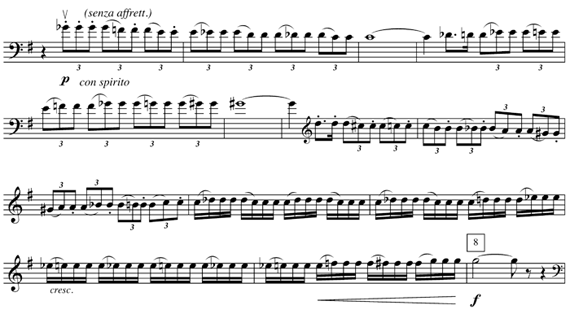
Example 21. Marcia, between 2 mm. after RN 7 to RN 8.
In the passage from RN 11 to 6 mm. after RN 11, Rota again makes use of chromatic scale fragments, but this time, in an even more difficult manner since it calls for a combination of techniques presented in Chapters 2b, 4a and b, 6, 7, and 8. At 3 mm. after RN 11, Rota uses a chromatic scale starting on f1 working its way down for one octave, in which each note is intercalated with the initial f1. By doing so, he structures a line on the chromatic scale and incorporates every possible interval within a single octave. Similarly, at 4 mm. after RN 11, Rota transposes the pattern to d1, after which the line ascends once again by an octave, as shown in the example below:

Example 22. Marcia, RN 11 to 6 mm. after RN 11.
2.4.2 — Aria
In 1993 Lucia Borsatti entitled her published interview with Petracchi "The Master of Bel Canto."73 Indeed, the vibrato and the strong lyrical sensibility that Petracchi gives to his interpretations are of such incomparable intensity as to invite comparison with the golden age of Italian opera. In one especially fine example, we can hear Petracchi's interpretation of Una Lacrima by Gioacchino Rossini on the compact disc Franco Petracchi in Tokyo I with the Tokyo City Philharmonic Orchestra.74 This performance demonstrates Petracchi's intense vibrato and lyrical phrasing, two characteristics of his playing that influenced Rota's composition of the Aria movement.
As Petracchi states, the Aria was composed in 1968.75 Throughout this movement, Rota provides the performer opportunities to explore all the lyrical phrasing of which the bass is capable. The soloist's first entrance, shown below, gives the first of them:

Example 23. Aria, from beginning to RN 1.
The intense lyrical character of this first theme requires the soloist to demonstrate a proficiency in vibrato and control of bow technique in order to bring out different timbres and dynamic levels throughout the passage. Furthermore, the first theme demands precise intonation from the player, especially if one opts to play this theme on just one string (the G string). Necessary practice for this technique is found in Chapter 11 of Higher Technique,76 wherein Petracchi presents an exercise in order to prepare the left hand for a shift on the same string, from the higher positions to the lower positions and vice-versa. This exercise (shown below in Ex. 24) is important for developing precise intonation in changing positions on the same string, as the first theme of the Aria demands.

Example 24. Higher Technique (chapter 11, first and second measures, p. 16).
2.4.3 — Finale
In the Finale, Rota explores many aspects of virtuosity on the double bass. The Finale is an Allegro marcato, a relatively fast tempo, creating technical challenges including arpeggios, double stops, and many string crossings. In doing so, Rota exploited Petracchi's unique virtuosity and the characteristic technical abilities that Petracchi was displaying at the time the piece was composed. In many instances of the Finale, Rota writes arpeggios in different rhythmic figurations and keys, e.g., in the first measure, where Rota starts the movement exploring the G major arpeggio (with harmonics), and at 8 mm. before RN 1, where he writes a B-flat major arpeggio. Both examples are given below:

Example 25A. Finale, first measure.

Example 25B. Finale, 8 and 7 mm. before RN 1.
As seen earlier in this chapter, Petracchi, in Higher Technique developed innovative exercises to improve the playing of scales, arpeggios and harmonics. In Chapter 5 of the book there are scale exercises with Petracchi's system of fingering using the thumb in several unorthodox positions in order to facilitate agility. In Chapter 18, Petracchi presents his approach to arpeggios and harmonics. Rota used a great deal of arpeggiated passages in the Finale, as in the section at 6 mm. after RN 10 all the way to the end of the movement. Here, a G major arpeggio is developed in consecutive sixteenth-notes in a fast tempo all the way to the end of the piece. Even though Higher Technique only has one chapter in which arpeggios are worked, in Petracchi's lessons, he gives great importance to arpeggios making each student work exhaustively, resembling the end of the Divertimento in which Rota challenges the player with 11 measures of the G major arpeggio. Another virtuosic feature used by Rota in the Divertimento is the use of double stops. To explore this device in detail, we will now turn to the Allegro, the first movement of the Divertimento, but the fourth to be composed.
2.4.4 — Allegro
The first movement of the Divertimento draws on techniques that are found in several different chapters of Petracchi's method. We will begin with the passages based on double stops. In Chapter 9 of his text,77 Petracchi, using Selmi's etude, develops a unique fingering in which the thumb is used to play double stops in thirds and fifths precisely in tune. Several examples are given below:
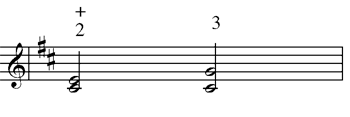
Example 26A. Higher Technique (chapter 9, measure 10, p. 15).
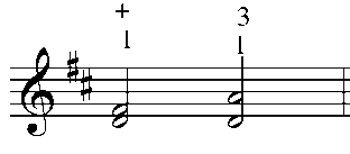
Example 26B. Higher Technique (chapter 9, measure 12, p. 15).
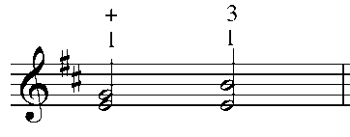
Example 26C. Higher Technique (chapter 9, measure 14, p. 15).
Petracchi suggests that these exercises be played in all keys. In Chapter 19, Petracchi uses another Selmi etude to demonstrate how the thumb can be used to play fourths in "thumb position," as shown in the example below:

Example 27. Higher Technique (chapter 19, explanation, p. 27).
Rota begins the introduction of the Allegro with a G major arpeggio, followed by double stops of sixths, fifths, fourths, sixths and thirds as shown in the example below, mm. 2 to 5 after RN 5:

Example 28. Allegro, 2 to 5 mm. after RN 5.
Here the resemblance between this passage and Petracchi's double stop exercises involving the thumb is striking. It is very demanding technically to play double stops in tune, especially when the thumb is being used to play part of the chord. Today more and more bass players are acquiring the skill of using the thumb to play chords in many different positions on the fingerboard, but at the time Rota composed the Divertimento such a technical device was not in vogue and not as common a technical solution as it is nowadays.
After the introduction section of the Allegro is over and the movement is well underway (i.e., at RN 7), Rota inserts passages that require the chromatic thumb position toward which Petracchi devoted much attention in his method, e.g., at mm. 2 to 5 after RN 7, as given here.

Example 29. Allegro, 2 to 5 mm. after RN7.
For the purpose of comparison, here are two examples from Chapter 3 of Higher Technique in which Petracchi explored the use of the chromatic position:
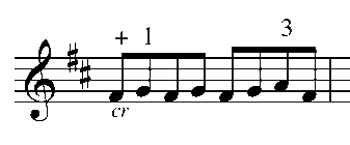
Example 30A. Higher Technique (chapter 3, measure 3, p. 3).
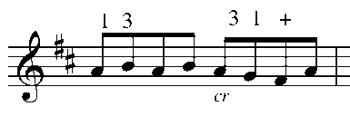
Example 30B. Higher Technique (chapter 3, measure 12, p. 3).
A comparison of the passage at 2 mm. after RN7, beat 2, involving the four sixteenth-notes on pitches E, F, and G (example 29) with the second half of the measure in example 30A, involving pitches F-sharp, G and A shows that both passages are based on the same interval pattern and in the same order, with the latter passage transposed up a major second. In comparing 3 mm. after RN7 beat 2, involving a sixteenth-note pattern using pitches C, B-flat and A (example 29) with the second half of the measure in example 30B (pitches A, G, and F-sharp), one sees that they also share the exactly interval pattern content in the same order but with the latter passage now transposed down a minor third. A performer could use the same fingering introduced in Petracchi's method to realize both the passages in the Divertimento.
Another similar use of the chromatic position in the Divertimento is found between rehearsal numbers 9 and 10; here Rota wrote a passage that technically and musically bears a great resemblance to Higher Technique's Chapter 3 as demonstrated in example 30A, taken from the second half of the measure. The passage of Rota's music, at RN 9 to 1 m. after RN 9 in example 31 can be compared to example 30A from Higher Technique's Chapter 3:

Example 31. Allegro, at RN9 and 1 m. after RN9.
Note that Petracchi's cr left-hand position developed in Chapter 3 could be used to realize this passage. Note also that this passage has the same interval content (but in different interval order) as example 30A (second half of the measure), but transposed a major third above (A-sharp, B and C-sharp).
Proceeding further in the first-movement Allegro, one finds a Poco Sostenuto section (from RN 15 to 7 mm. after RN 16) that again showcases the "Bel Canto" style of Petracchi's playing, as evidenced in Example 32:
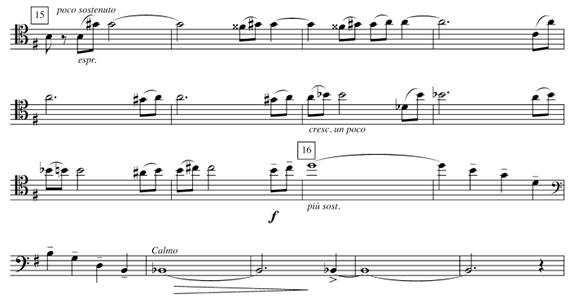
Example 32. Allegro, at RN 15 to 7 mm. after RN 16.
In this passage, Rota wrote a slow lyrical line that gives the interpreter an ample length of time for intensive "singing," with time to use vibrato on each note as well as enough time to concentrate on phrasing. In writing this passage, Rota also gave Petracchi the chance to show his ability to express different nuances of timbre and dynamic levels, as demonstrated by Petracchi's recording of the Divertimento with the Tokyo City Philharmonic Orchestra.78
According to Petracchi, another influence that his lessons had on the composition of the Allegro is explained in an unpublished videocassette recording (VHS) of a solo recital by Franco Petracchi.79 In this recital Petracchi began by commenting to the public how Rota used some of the material that Petracchi was using in his classes with his students. Petracchi relates that Rota purposely wrote a passage capturing the common errors that he heard students make during their lessons with Petracchi. Very frequently, in playing arpeggios, the students would never play the tonic final note of their arpeggios in the higher positions in tune. In response Rota purposely ended the final passage of the Allegro (beginning 2 mm. after RN 23 and shown below) on a dotted half B-double flat, thus mimicking the mistake: i.e., B double-flat instead of a proper A-flat.

Example 33. Allegro, 2 to 3 mm. after RN 23.
As already noted, the precise manner in which Petracchi's teaching at the Bari Conservatory influenced Rota's writing of the solo bass part can never be known. Nevertheless, the technical passagework discussed above provides opportunities that are well-suited to demonstrate the practicality and versatility of Petracchi's innovations in the playing of difficult music. The next chapter is concerned with the final phase of the collaboration between composer and performer: revisions to the work that were made after its publication in 1973.
|
|





































